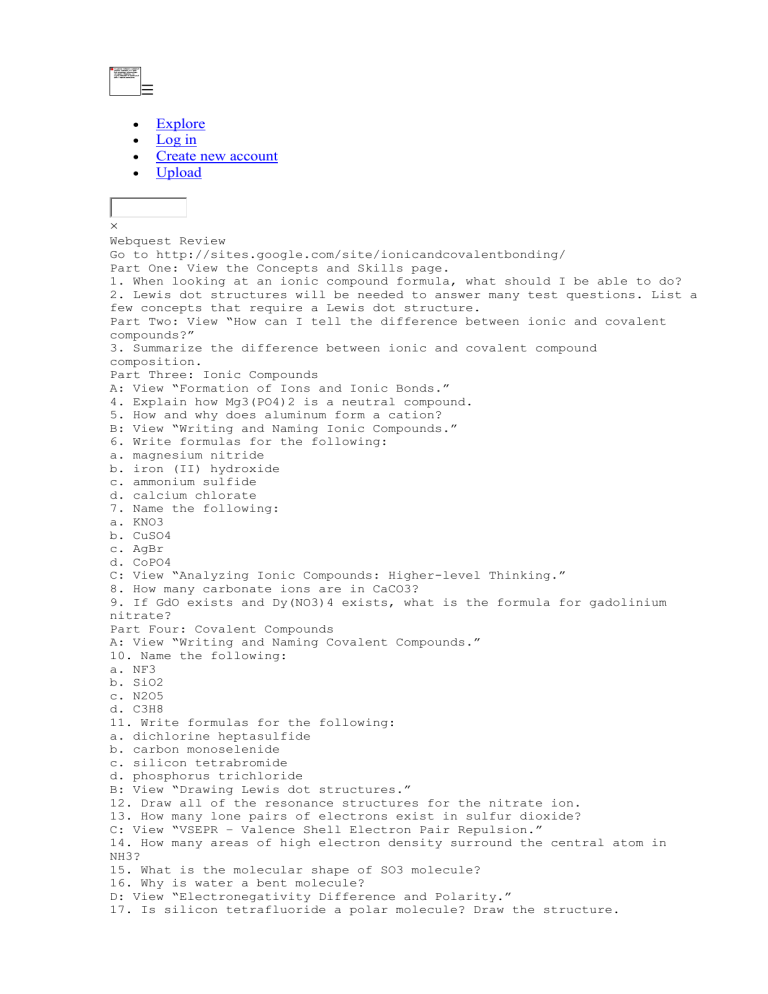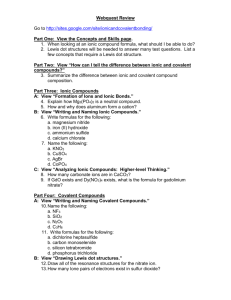BondingWebquestReview

☰
Explore
Log in
Create new account
Upload
×
Webquest Review
Go to http://sites.google.com/site/ionicandcovalentbonding/
Part One: View the Concepts and Skills page.
1. When looking at an ionic compound formula, what should I be able to do?
2. Lewis dot structures will be needed to answer many test questions. List a few concepts that require a Lewis dot structure.
Part Two: View “How can I tell the difference between ionic and covalent compounds?”
3. Summarize the difference between ionic and covalent compound composition.
Part Three: Ionic Compounds
A: View “Formation of Ions and Ionic Bonds.”
4. Explain how Mg3(PO4)2 is a neutral compound.
5. How and why does aluminum form a cation?
B: View “Writing and Naming Ionic Compounds.”
6. Write formulas for the following: a. magnesium nitride b. iron (II) hydroxide c. ammonium sulfide d. calcium chlorate
7. Name the following: a. KNO3 b. CuSO4 c. AgBr d. CoPO4
C: View “Analyzing Ionic Compounds: Higher-level Thinking.”
8. How many carbonate ions are in CaCO3?
9. If GdO exists and Dy(NO3)4 exists, what is the formula for gadolinium nitrate?
Part Four: Covalent Compounds
A: View “Writing and Naming Covalent Compounds.”
10. Name the following: a. NF3 b. SiO2 c. N2O5 d. C3H8
11. Write formulas for the following: a. dichlorine heptasulfide b. carbon monoselenide c. silicon tetrabromide d. phosphorus trichloride
B: View “Drawing Lewis dot structures.”
12. Draw all of the resonance structures for the nitrate ion.
13. How many lone pairs of electrons exist in sulfur dioxide?
C: View “VSEPR – Valence Shell Electron Pair Repulsion.”
14. How many areas of high electron density surround the central atom in
NH3?
15. What is the molecular shape of SO3 molecule?
16. Why is water a bent molecule?
D: View “Electronegativity Difference and Polarity.”
17. Is silicon tetrafluoride a polar molecule? Draw the structure.
18. Is ammonia (NH3) a polar molecule? Draw the structure.
19. Is carbon dioxide a polar molecule? Draw the structure.
E: View “Intermolecular Forces.”
20. Explain why magnesium chloride should dissolve in water.
21. Which of the following would be the most difficult to boil: H2O, CH3Cl,
CO2
Why?
22. Carbon tetrachloride experiences dispersion forces. Why?
F: View “Naming and Writing Formulas for Acids.”
23. Name the following acids: a. H2CO3 b. H2S c. H3PO3 d. H3P
24. Write the formula for the following acids. a. Acetic acid b. Hydrochloric acid c. Nitrous acid d. Nitric acid
Part Five: Comments/Suggestions
Rate the website according the following areas. 1 = unhelpful; 5 = very helpful
Difference between ionic and covalent page
Forming ions and ionic bonds page
1
1
2
2
Naming and writing formulas for ionic page
Analyzing ionic compounds page
1
1
3
3
4
4
2
2
3
3
4
4
5
5
5
5
Writing and naming covalent page
Drawing Lewis dot structures page
2
3
3
3
2
2
2
2
1
1
1
1
VSEPR page
Electronegativity Difference & Polarity page
Intermolecular Forces page
1
4
4
4
5
3
3
4
4
5
5
5
5
Naming and Writing Formulas for Acids page 1
2
3
4
5
Comments or suggestions for improvement of website:
Download
1.
Science
2.
Chemistry
BondingWebquestReview.doc
Webquest Review
Bonding - Mrs. Streible`s Classroom
Advanced Placement Chemistry Summer Assignment 2014
Compounds A combination of two or more elements Elements form
Practice Test
Organic Chemistry
Bonding and Nomenclature Review
Sample second midterm exam
Atoms, Bonds and Water - Florida State College
Chapter 3: Ionic and Covalent Compounds Chapter 3: Ionic and chepter-wise_questions chapter 4 - forces between particles
WEEK 7 Feb. 19-22 studylib © 2016
About studylib DCMA Abuse





